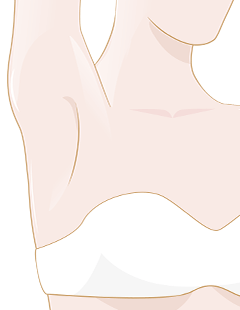What is chlamydia and how do you get it? And do you know if chlamydia is contagious?
If you haven't had chlamydia yourself, you probably know someone who has. Chlamydia is one of the most common STIs in the world. There are hundreds of thousands of new cases of chlamydia every year, but because the disease can be asymptomatic, the actual number is estimated to be twice as high. If you participate in unprotected sex, you should therefore be aware of the most common chlamydia symptoms.
Table of contents
What is chlamydia?
Chlamydia is caused by a bacterium called chlamydia trachomatis. Chlamydia is a sexually transmitted disease that is spread through unprotected sex, and the problem with chlamydia is that many people do not experience any symptoms at all, even though they have been infected with the bacterium. Many are infected without realising it, which can have long term consequences.
Women are at risk of developing an inflammation of the ovaries, while men are at risk of developing inflammation of the epididymis. Both are diseases that, in the worst case scenario, can make you sterile and unable to have children.
Chlamydia is an infection that causes inflammation of the urethra and cervix. In the UK, chlamydia is most commonly a sexually transmitted disease, but in the tropics, it can also cause the eye disease trachoma.
Chlamydia invades cells - mainly those in the urethra and cervix - and multiplies. Chlamydia can also affect the cells in the rectum and in the eyes and because of the sequelae that chlamydia can cause, it is something you should take seriously.
Who gets chlamydia?
Although chlamydia can affect anyone, young people are particularly affected by the disease, but figures show that more and more people over the age of 40 are being diagnosed with the disease - which may be due to this generation, not being consistent in their use of condoms.
Hundreds of thousands cases of chlamydia are detected each year, but it is feared that at least twice that number are infected. As chlamydia can result in sterility and infertility, an untreated chlamydia infection is not something you should take lightly.
Chlamydia symptoms - What does chlamydia feel like?
The dangerous thing about chlamydia is that the symptoms are either very mild or nonexistent. Chlamydia can therefore be asymptomatic and only 50% of affected women and 80% of affected men experience symptoms associated with the disease.
Chlamydia symptoms in men
Men may experience:
- Discharge from the urethra
- Burning during urination
- Inflammation of the epididymis
In men, it is particularly important to look out for urethritis as it is an important symptom. There will often be a clear discharge from the urethra, and there may also be itching and burning during urination. As a man, you may experience discharge from the urethra or rectum if you have had anal sex. Similarly, if you have a fever, this may be a symptom of chlamydia.
Chlamydia symptoms in women
Women may experience:
- (increased) discharge
- Burning sensation during urination
- Light bleeding
- Pelvic inflammatory disease
In women, it can be particularly difficult to spot the condition as it is very mild or shows no symptoms at all. However, if you experience increased vaginal discharge or burning during urination, this could be a sign of chlamydia. The discharge can come from both the urethra and the cervix, and as a woman you may also experience abdominal pain and, in rare cases, fever. If you have had anal sex, you may also have a discharge from the rectum.
Are there other signs of chlamydia?
In rare cases, you may find that chlamydia causes a rash on the genitals in the form of fungal, wart or cauliflower-like growths. The rash is usually painless and usually disappears after a few weeks.
Men can get a special type of chlamydia called chlamydial granuloma, which starts out as ordinary chlamydia. It later develops into swollen lymph nodes in the groin. The infection may appear as a sore or blister on the penis or up near the rectum if you have had anal sex. The sore is painless and will heal within a week or so. A few weeks after the ulceration, the lymph nodes in the groin may swell up.
Both these signs are very rare - but sure signs of chlamydia.
If you experience any of the above, you should see a doctor immediately and be treated with antibiotics.
The most common signs of chlamydia:
- The most common symptoms are burning during urination and discharge from the urethra and, for women, also from the cervix
- Men may have itching in the urethra
- Women may have spotting or bleeding during intercourse and may have heavier periods
- Men may get epididymitis
- Pelvic inflammatory disease in women
- Pain in the lower abdomen
- Pain in the testicles
You can also take a look at:
> Vaginal fungus infection (thrush)
> Burning after intercourse - how to avoid it?
Did you know:
Many women and men experience itching, burning and irritation after sex, which can be very uncomfortable. If sex is the cause of the problem, using a gel to relieve dryness and intimate discomfort can help. Australian Bodycare has developed a gel containing tea tree oil. Intim glide is dermatologically tested and can relieve intimate dryness and discomfort and give you both a sensual experience.
Intimate glide from Australian Bodycare is a light, smooth and sensual gel. It contains natural Tea Tree Oil, which can help relieve the itching, burning, dryness and irritation that many women experience during and after sex.
How do you get chlamydia?
Chlamydia is basically a sexually transmitted disease and therefore sexual intercourse is required for the infection to be transmitted.
In women, the bacteria settle in the cervix at the top of the vagina, but it can also occur in the urethra.
In men, the bacteria settle in the urethra, but both men and women run the risk of the bacteria spreading to the internal genitals.
How is chlamydia transmitted?
Chlamydia is transmitted through contact between mucous membranes. Mucous membranes include the rectum, vagina, penis and mouth. Therefore, chlamydia can be transmitted through genital contact, oral sex and anal sex. However, chlamydia cannot be transmitted from the mouth - only from the penis, vagina or rectum, so chlamydia is not transmitted through kissing. However, it can be transmitted to the mouth, for example if you give unprotected oral sex to someone who is infected with chlamydia.
How easily is chlamydia transmitted?
Chlamydia is very easily transmitted, and the bacteria can also easily spread to the internal genitals. Chlamydia can also be transmitted if you share sex toys with an infected person.
How quickly does chlamydia spread?
As soon as you are in contact with an infected person, you can become infected. The disease may be present even if you have no symptoms. It usually takes 5 to 21 days from the time you are infected until you develop any symptoms.
If you carry the disease without treatment, it is estimated that the body can heal itself after 1 to 2 years. However, this should not be done as the sequelae cannot heal on their own and should be prevented before they occur.
Can chlamydia be transmitted through oral sex?
Yes, it can. Chlamydia can be transmitted if you give unprotected oral sex to someone who is infected with the disease. However, chlamydia cannot be transmitted from mouth to mouth, so kissing is not a risk.
Also read: How to relieve dry vaginal mucous membranes
How do you avoid chlamydia?
By practising safe sex. To avoid catching chlamydia altogether, you must avoid contact between your mucous membranes and the mucous membranes of someone who has chlamydia. You should also avoid contact with pre-cum, sperm or vaginal secretions.
However, it can also be transmitted if you touch the genitals of an infected person and then touch your own genitals.
Chlamydia can be transmitted through sex between a man and a woman, as well as sex between two men or two women.
Depending on the type of sex you have, you can protect yourself in the following ways:
- Condoms: you can use them for oral sex, vaginal sex, rectal sex or sex toys
- Gloves: you can use gloves specially designed for the purpose, which you can use when touching the vagina, rectum or penis
- Licking patches: you can use them if you need to perform oral sex. Both vaginal and anal
Who is at particular risk of getting chlamydia?
- People with multiple partners
- People who have unsafe sex
Some people may be particularly at risk of becoming infected with chlamydia. If you have many changing sex partners, you are at particular risk of getting chlamydia.
Women are more likely to be diagnosed with chlamydia, but this is probably because women are tested more often.
Nevertheless, heterosexual men are responsible for the largest proportion of chlamydia cases, but this does not mean, for example, that the risk is lower for male couples. Men who have sex with men are generally at higher risk of contracting sexually transmitted diseases such as syphilis and gonorrhoea.
Most of those infected are aged between 15 and 29 years, and figures show that 5% of young people in Denmark are infected with chlamydia.
Also read: Getting rid of vaginal itching
How is chlamydia diagnosed?
The doctor can make the diagnosis in different ways. This can be done either by taking a swab from the urethra and, in women, also from the cervix. However, chlamydia can also be diagnosed from a urine sample, which is now the most common way of diagnosing chlamydia.
Is chlamydia similar to other STIs?
Chlamydia can be very similar to gonorrhea, but they need to be treated very differently. Therefore, it is also important to get an accurate diagnosis, which is why you should be tested for both diseases if you have symptoms from the urinary tract.
When can the diagnosis be made?
A doctor can only make a diagnosis 1 to 2 weeks after infection.
Chlamydia test - how to test for chlamydia?
If you go to the doctor to be tested for chlamydia, this will be done either by swabbing the urethra and, in women, also the cervix. A urine test can also be done, which is the most common method among Danish doctors.
However, men will usually have a urethral swab test as the urine test is still relatively new.
Chlamydia home test
If you do not want to be tested by your doctor, it is also possible to take a chlamydia test yourself. However, if you suspect that you are infected with a sexually transmitted disease, you also have the right to be examined by a doctor other than your general practitioner.
Today, you can buy chlamydia tests online and test yourself at home. It is recommended that you seek medical advice for optimal treatment and do not try to buy medicines online. The treatment for chlamydia is an antibiotic and it is prescription-only, which means you cannot buy it yourself.
Women can get an indicative test, which, like a pregnancy test, will give you an answer within 10 minutes, while men need to send the sample to a laboratory and you will get an answer within a week. The address to which you need to send the sample will appear on the test pack you ordered online.
If the test is positive, you should see a doctor to get treatment for chlamydia.
If you have symptoms but the test was negative, you should see a doctor as these could be symptoms of other more serious conditions.
Chlamydia treatment - How to treat chlamydia
Although chlamydia may seem like a serious disease, it is fortunately easy to treat and in most cases you can cure the disease with antibiotics. After 7 to 10 days, the infection is gone and you are no longer infectious.
In the UK, chlamydia is currently treated with Azithromycin, which is a single-dose antibiotic.
In rare cases, it may be necessary to take the medicine for a longer period of time, but this is something you should discuss with your doctor.
Chlamydia is treated with tablets
It is important that both you and your partner are tested and treated. The treatment is a course of tablets.
Frequently asked questions and answers about chlamydia
Can you have sex while you are being treated for chlamydia?
As long as you are being tested and treated, you should either not have sexual intercourse at all, or you should only have safe sex with a condom.
It is also a good idea to wait at least 7 days after treatment before having sexual intercourse again. It is also important that the symptoms have completely disappeared before you have sexual intercourse again.
If you experience dryness, irritation or itching in the intimate area associated with chlamydia, you can use products such as Femigel or Intimate Glide to prevent irritation before, during and after sex. This is not a cure for chlamydia and it is still very important to use a condom if you are infected with or being treated for chlamydia.
Should you tell your previous partners?
It is very important that the person or people you have been with in the last 6 months or so are also tested for chlamydia. If you don't, there is a high risk that you will either get infected again or that others will catch the disease. So, while it's never a fun message to pass on, it's very important that you do so.
Can you get chlamydia more than once?
Yes, you can get chlamydia more than once. Treatment for the infection does not make you immune to future episodes, so even if you have been diagnosed with chlamydia and treated once, you can still risk getting it again if you have unprotected sex with someone who has chlamydia.
When should you get tested for chlamydia?
Since many people do not experience symptoms of chlamydia, there are certain situations where it is a good idea to check if you are infected. Therefore, you are recommended to take a test in the following situations:
- Before an induced abortion
- Before insertion of an IUD
- In young women with frequently changing sexual partners
- In young women with increased vaginal discharge
- In pregnant women under 25 years of age
- In younger women with symptoms of pelvic inflammatory disease
- In case of spotting or other bleeding disorders (also in contraceptive pill users)
In addition, it is recommended that sexually active people under the age of 25 should be tested for chlamydia if they change sexual partners frequently. In addition, it is always a good idea to get tested if, for example, you are starting a new relationship with someone and want to avoid using a condom.
What does your future look like, if you have chlamydia?
If you have a chlamydia infection that is treated in time, there are no side effects.
An untreated chlamydia infection can spread and cause pelvic inflammatory disease (PID) in women and inflammation of the epididymis in men.
A side effect of pelvic inflammatory disease can be that the fertilised egg has difficulty passing through the ovary to the uterus, preventing the woman from becoming pregnant.
A chlamydia infection can trigger Reiter's syndrome, but the condition can also occur after an intestinal infection. Reiter's syndrome is a rare condition characterised by pain in one or more joints, which may be tender and swollen, inflammation of the urinary tract, inflammation of the eyes and a rash on the mucous membranes and skin. The condition predominantly affects younger men who have a particular tissue type.
Chlamydia causes 500 couples each year to become sterile and unable to have children because they have had chlamydia. The only way these couples can have children is through artificial insemination.
Chlamydia causes many women to get pregnant outside of the womb.
The information in this article should not be used as a basis for diagnosis or treatment. We recommend that you contact your own doctor.






